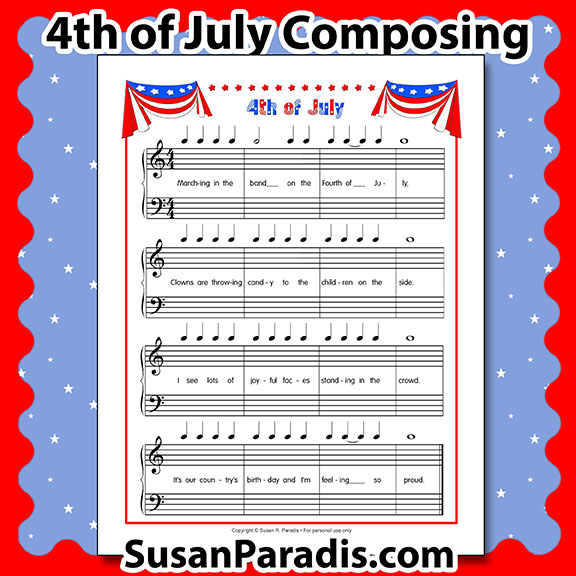Fourth of July Composing Activity

Click here for the on-the-staff composing bundle in the store.
If you have summer students or a summer music camp, you might be interested in this Fourth of July composing activity. This activity may take too long to do in a lesson, so students can do some at home, or you can work on it for several weeks in the lesson.
As an introduction ask the students what instrument they would like to play in a marching band. Ask what is the difference in a band and an orchestra? Often children have never thought of that.
First learn the rhythm by saying and tapping the words. Find the syncopation and circle it if necessary. For younger students you may want to cross through the tied notes. Ask if they know why there are two notes over the word “band”.
Students can write their music in any key; this does not have to be in middle C position. Beginning composers can write just a melody and alternate using the right and left hand on each staff system. Older students will want to write a melody with harmony. If they know tonic and dominant chords, even the 2- note variety, they will want to use them. Encourage all students to play a drum pattern in 5ths as an introduction. They can also improvise a coda using the same rhythm with the drum getting softer as the band marches away in the distance. It might be old hat to us, but not to the student. Elementary children think very concretely.
Remember good composing techniques such as repetition or sequence. I have already built in rhythm repetition. There is nothing wrong with some lines being the same. It is usually safe to use some sort of question and answer form. Often I will tell them to repeat one line and we decide that before we start to compose. This piece has the same rhythm in the first and last line. Show students how the melody can be the same except for the last few notes. The first line can end on the dominant and the last line on the tonic. It is OK to set some limits, like only use steps and repeats, or steps, skips and repeats. This actually helps the students.


This is an excellent summer lesson activity. Thank you!
Susan,
We’re teaching a ComposeYourself camp this week. The Fourth of July activity was a great warm-up. Thanks so much!
Lee
ComposeYourself camp sounds like a great idea. If you have time, send us the details!
This is perfect Susan! Thanks so much! 🙂